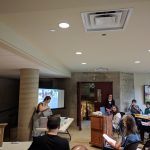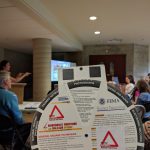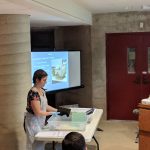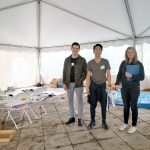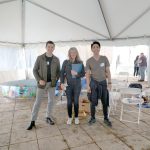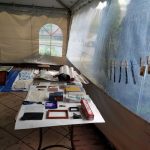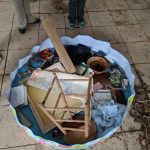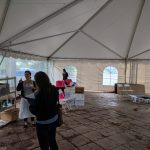Contributed by Hoang Tran, Director of Archives
Preparing for a disaster is one of the most important things a museum can do to safeguard collections. Preparation ensures the museum has the knowledge, skills, and abilities to fulfill its role as stewards of collections.
On May 16, 2018, Alex Till, Liz McDermott, and myself attended the Conservation Center for Art and Historic Artifacts’ (CCAHA) Collections Care Training workshop to gain some hands-on training on disaster response and recovery.
Mercer Museum & Fronthill Castle was kind enough to play host for approximately 30  library, archives, and museum (LAM) professionals from the region. Samantha Forsko, Preservation Specialist for CCAHA began the workshop reviewing the standardized Incident Command System (ICS) approach for emergency response. Included in her presentation were hypothetical scenarios when disasters occur at cultural institutions and how to handle certain objects–books, paper, art, artifacts, etc.
library, archives, and museum (LAM) professionals from the region. Samantha Forsko, Preservation Specialist for CCAHA began the workshop reviewing the standardized Incident Command System (ICS) approach for emergency response. Included in her presentation were hypothetical scenarios when disasters occur at cultural institutions and how to handle certain objects–books, paper, art, artifacts, etc.
The majority of the workshop was spent applying what we learned in the classroom in a simulated disaster setup in the courtyard of the museum. The participants split up into three teams and were given specific ICS roles. Each participant had a chance to play a designated role to get a better sense of how the ICS worked in the field.
We recount our experiences in the “field” applying the ICS during a disaster.
Liz McDermott, Conservation Technician:
During the first round, I was in the Operations Section as the Object Retrieval Strike Team Leader. As the team leader, I oversaw the systematic removal of damaged objects based upon the information given to me by the Incident Commander. This was a really tough job and I found that, under pressure, I tended to want to dive into action too quickly without taking the time to adequately plan with the Logistics and Triage Treatment Team members who oversaw where the objects were going and what materials the objects will need when they land.
During the second round, I was a Triage Treatment team member. I felt much more comfortable with handling and caring for objects after they were retrieved from the disaster site and preparing landing sites for incoming objects. That being said, I think that all team members were much more calm the second time around since we were able to better understand the function and duties of each division and how they played out in real life—rather, “simulated” life.
I look forward to using what I’ve learned to help with re-vamping our own Disaster Plan before we reconfigure our collection in the new storage facilities slated to be completed by next spring. This was a fantastic workshop, but there is still so much more to learn—as one can never be too prepared, especially when it comes to caring for the oldest collection of American Art in the country.
Alex Till, Associate Registrar:
For the first round, I was made the Liaison Officer. This was the first time I was ever exposed to the Incident Command System, so I was honestly pretty unsure of what I was supposed to be doing and I think that others in the group shared the feeling. It ended up being more of a hypothetical job during the simulation. I ended up contacting a outside contractor to set up space to freeze some materials and I contacted an outside conservator to examine the painting we had in our pool. Valuable tasks, but in the case of the simulation, they were imagined because there was no one there to play those outside roles. After I completed those tasks, I was switched to the object retrieval team and helped fish things out of the water. I felt more comfortable in that second role because I have had experience handling a variety of objects throughout my career and because of the lack of hypothetical scenarios.
For the second round, I was made Incident Commander, so I was in charge of the whole team. After being briefed by the previous commander and looking over our project area, it became clear to me that we were running out of space to handle the materials that were remaining in our pool. I assigned most of the team to object triage and had them rotate the objects already saved from the water and make room for new ones. Based on the first round, I saw that we had before had too many people retrieving objects and not enough dealing with them after they came out of the pool. I think the whole group was a little more certain of the different roles the second time around. While I think I did a passable job as the leader, I felt a little awkward giving out orders and said as much to the team I was working with. Everyone told me I did a fine job though, so I’ll chalk that up to first time leading jitters.
I haven’t yet been heavily involved with our disaster plan here at PAFA, but I think that the experience here gave me a good impression of the confusion that can come about from just trying to organize a response to a disaster. I was glad to get the experience, even though it was simulated, and though I doubt that I’ll be assigned an Incident Commander any time soon in a real disaster, I think it was a valuable exercise.
Hoang Tran, Director of Archives
I’ve heard of the ICS in my previous work in disaster planning and emergency preparedness. I shared the same feelings with Alex and Liz when we played the ICS roles in the simulation. Moreover, since it wasn’t a “collection” we oversee, placing value on the object compounded the difficulty. For the first round, I was selected as the Triage/Treatment person. I felt comfortable in the position since the objects were things I’m accustomed to handling—photographs, negatives, textiles, paper, etc. Our disaster supplies were limited so we had to be resourceful in our efforts to treat the objects. I will admit, my group was a bit frenzied in regards to the chain of command and communication system since we were all basically strangers. I found some comfort since I had some colleagues on my team—Lillian Kinney (archivist) from the University of the Arts and Jennifer Vess (archivist) from the Academy of Natural Sciences.
After our debrief we had a chance to change roles for the second round.
After we assessed the situation with the new Incident Commander, we opted to use the flexibility of ICS and eliminated or combined certain roles. I ended up playing two roles, Safety and Logistics officer. Like Alex, we felt triage/treatment needed more people and object retrieval needed less people. We also knew we needed more space to treat the objects. I setup four staging areas so the object retrieval and triage teams could work more efficiently. As the session went on, we soon realized that documentation and tracking was really important in the overall scheme of the disaster. Essentially, documentation gathers all the data to discuss necessary services with vendors and senior staff. More importantly, there is no need to unnecessarily enter the disaster area since the documentation details all the objects impacted by the disaster.
Overall, it was a great experience. It was equally nice meeting fellow LAM professionals interested in disaster preparedness. Hearing their experiences and training alongside each other made for a very enjoyable and informative day.
